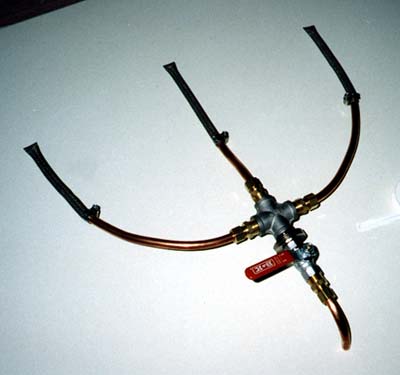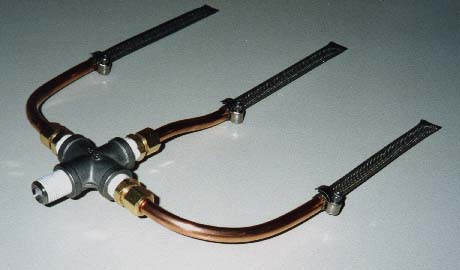Al's Homebrewery - Page 4

Here's the TridentTM Mash System. Although
I was happy with the EasyMasherTM
in my 8-gallon enamel kettle, I felt that I should get better
efficiency with multiple screens considering the larger cross-sectional
area of the 18.75-gallon kettle. There is a slight downward bend on all
three prongs of the Trident, which places the screens in contact with the
bottom of the kettle. This minimizes the amount of wort that is left behind
after draining.
The brass fittings are 3/8" compression to 3/8" male NPT.
The tubing is 3/8" OD soft copper. The 3/8" ball valve, brass
fittings, copper tubing, hose clamps, teflon tape, and stainless steel
washers (believe it or not!) were purchased at Ace
Hardware. The SureScreensTM at the
ends of the copper are available at many homebrew supply shops or from
Sheaf & Vine.
I bought the stainless steel 3/8" NPT cross and 3/8"
close nipple from McMaster-Carr.

A slightly closer photo shows the assembly after the teflon tape has been
wrapped on the fittings and the fittings have been tightened for a final
fit. The hose clamps may seem optional because the screens fit rather snugly
on the copper tubes, but you want to make sure the screens con't pop-off
during stirring. The outer two prongs of the assembly don't go all the
way to the walls of the mash tun. If they did, this would increase the
likelyhood that sparge water would channel down the smooth walls of the
mashtun and bypass all the sugars trapped in the grain bed. Make sure the
compression fittings are tight: I made one batch where I accidentally
swiveled one of the prongs upwards into the mash. The result was that as
soon as the level of the wort dropped below the top of the highest prong,
air could be drawn into the wort if the runoff rate is too high. Furthermore,
it increases the likelyhood that some sugars will be left in the stagnant
part of the grain bed below the swiveled prong.
Back to Page 3 Next
Page
To the BrewInfo Page (Home)
Copyright © 1997 Al Korzonas - All Rights Reserved

